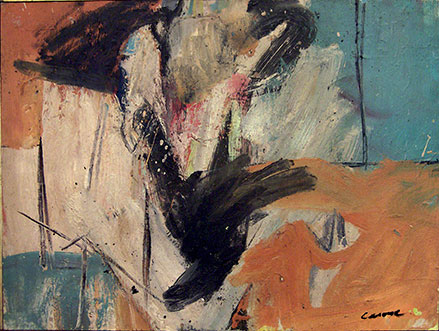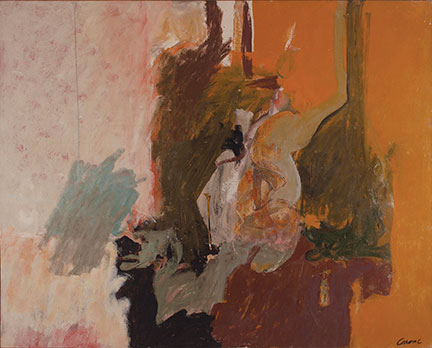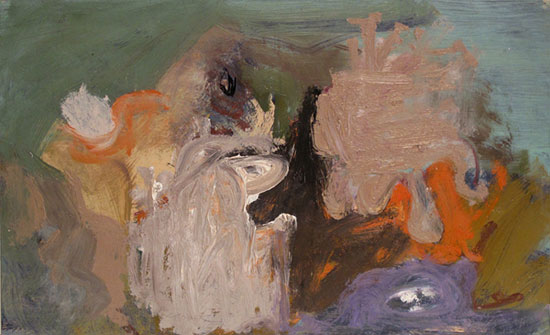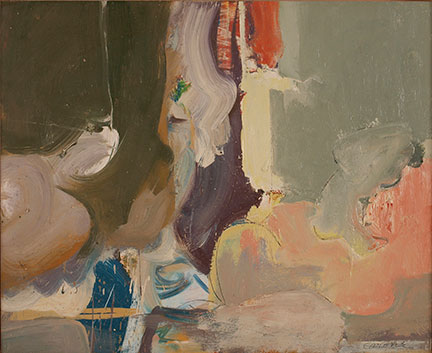The paintings of Nicolas Carone, in “The East Hampton Years: Paintings from the 1950s” at the Pollock-Krasner House and Study Center in Springs through July 27, 2013 provide a perfect opportunity to better understand the meta complex conceptual basis of Abstract Expressionism, a matrix that has mystified and confused viewers and arts writers ever since its appearance more than half a century ago.
It may be that the passage of time has given us a clearer way to see and think about the movement, and Carone, one of Abstract Expressionism’s classicists, provides us with textbook examples.
.

"Untitled" by Nick Carone, c. 1958. Oil on masonite, 19 x 26 inches. Collection of The Heckscher Museum of Art, Huntington, New York. Photo courtesy Washburn Gallery.
.
Though Carone’s paintings in this exhibition are somewhat smaller than the standard scale of the period and are not branded by the large gestures so frequently seen in Pollock, de Kooning, Kline or Norman Bluhm, these paintings from the 1950s resonate with that quality which is at the heart of Harold Rosenberg’s alternate term for Abstract Expressionism, “action painting.”
The use of the word “action” put an emphasis on “the act” performed by the artist in the “arena” of the canvas. In other words, these works are prime examples of what we now think of as “process” paintings. Because they are such authentic examples, based on Carone’s position among the Abstract Expressionists and the dates they were made, and because they are fresh to us, bereft of the hype heaped on some of his peers, we can just see the philosophy they espouse without the encumbering veils of monetary, i.e. “cultural”, importance.
Examining the paintings on view at the Pollock-Krasner house can help to shed light on this still misunderstood genre while also helping us to recognize Carone’s significant accomplishments within the movement as an artist, promulgator and teacher.
.

"Untitled" by Nick Carone, c. 1959. Oil on paper mounted on board, 23 7/8 x 34 inches. Photo courtesy Washburn Gallery.
.
To begin, it’s important to remember that Carone’s generation was trained in representational painting and drawing. Abstract Expressionism, the great revolution of their time, engulfed representation like a tsunami, by superimposing an entirely new type of expression, a new way to respond to reality. But aspects or vestiges of representation still existed in most, if not all, of their so-called “abstract” paintings.
In the end it wasn’t a completely or purely “abstract” style of painting, but, more accurately, a transitional approach. It was a movement in emphasis, from one dominant form of art that had existed for centuries to a new and challenging one; one in which the identity of the artist was offered as a simultaneous alternative to the traditional object, historically identified as “the subject” of a piece.
.

"Untitled" by Nick Carone, c. 1955. Oil on paper mounted on panel, 21 ¼ x 13 inches. Photo courtesy Washburn Gallery.
.
Gesture was part and parcel of the idea that paint has a life of its own and could be freed from the bonds of merely serving the purpose of representation. This was one of the essential messages of the revolution, a revolution that asserted it had discovered the lowest common denominator in the entire discipline of painting. This ideal, of finding the essential unit upon which the entire structure of painting was built, was inspired by discoveries made in science in the 19th and 20th centuries.
The discovery of the atom and all the attendant axioms and theories was crucial to most of these artists. In fine art, the paint itself was considered the critical, essential element, and the trend in seeing paint in this way began in the brush strokes of the Impressionists, was codified by Cezanne, and was rendered most clearly by W.J.M. Turner in his brushiest millennial masterpieces.
.

"Ear of Earth" by Nick Carone, c. 1960. Oil on canvas, 48 x 60 inches. Photo courtesy Washburn Gallery.
.
Going a step farther to make the case for the gesture as the most critical element, Abstract Expressionist artists recognized that you could make a gesture without paint but there would be no evidence of it, so gesture and paint were inextricably linked as the essential unit of painting, with the brush playing the key role.
What made Pollock the most radical artist of the day was that he even got rid of the brush, using paint in its most native and naked state, by enlisting the assistance of gravity to pour, drip, and splatter the liquid material on floor-bound canvases. Artists have been jealous of him ever since.
.

"Untitled" by Nick Carone, c. 1954. Oil on paper mounted on panel, 13 x 21 ¼ inches. Photo courtesy Washburn Gallery.
.
So this idea, of expression living in the gesture made in paint, could be equated to performance, to an “act” or “reaction” to subject. Similar ideas are at work in the singing of a song. A song is a fixed object, with words, a melody, rhythm and time creating its structure. But the singing of any song can be classified as how all of that is expressed. Singers can do all kinds of things with their voices that have nothing to do with the simple structure of the song as it is written. The singing of the song, the performance of it, is the same as making a gesture with paint, in that it expresses how the artist feels while representing something.
Through this new channel of expression, the idea of the subject in art became an explicit plurality. It could be both the things the artist sees as well as the inner feelings the artist has, as expressed by or through gesture. So Rosenberg’s terminology was accurate, and based on empirical evidence. Painting was performance, a living process, an act, which left the indications of its life in graphic marks, like footprints in the sand.
.

"Untitled" by Nick Carone, c. 1952. Oil on paper mounted on panel, 18 x 22 inches. Photo courtesy Washburn Gallery.
.
In finding a new freedom in painting—by being able to express emotions through gesture rather than having to assign feelings to some depiction in which meaning is indicated through the symbols used, in a literary way—a tremendous liberation took place. But some kind of referent, some connection, to the visual world was still necessary. Because of the way the human brain sorts visual information, it would be impossible for it to be otherwise.
In most of the art of the period, we can see the mimetic impulse still breathing under the assertion of gestures made with paint. So the idea of purity or of absolute abstraction was a fantasy, a kind of vacuum suggested by certain theorists, and that particular offshoot wound up coming to a dead end, cut off as it was from all sources of visual content.
As Carone put it, the act of painting was a method or “practice” of perception, a bridge between “the outer and inner worlds.”
.

"Escape Plan" by Nick Carone, c. 1958. Oil on canvas, 40 x 58 inches. Photo courtesy Washburn Gallery.
.
It’s my belief that the duality in the paintings of the period, the ambiguity between seeing and feeling, between the empirical and subjective, between representation and abstraction, between the self and the object, is actually the long-lost unifying weltanschauung of the mid-20th century generation, which has so often been represented as a very diverse field of formats, techniques and sensibilities.
But if we look at Guston’s abstractions done at about the same time as Carone’s paintings in this exhibition, we see mark making and vestiges of mimetic images jostling for ascendancy. If we look at de Kooning’s big brush strokes and paint scrapings and his “glimpses” of figures or landscapes, again, both vie for our attention. Look at Pollock: are his figures his gestures or are his gestures his figures?
In works by James Brooks, we feel nature in the phenomenology of his flowing, ever flooding-out plains of color; and even the non-gestural Rothko is still dealing with the dichotomy (and resultant ambiguity) between what the eye sees and derives from landscape (the horizon) and what the heart feels before a field of color. The list goes on and on.
The result of all that has been described above was called the "immediate splendor" by artist Alfonso Ossorio. Replacing the pleasure given by the sublime techniques of depiction of previous centuries, the new painting gave forth a beauty of its own in a more direct fashion. Paint and its applications replaced the Impressionist sunsets, gardens, seaside vistas and the like.
It is immediate because of the direct connection to emotion in the paintings. It is splendid because there is an incredible beauty in the raw impact on the senses of paint and color. In this, Carone's work is a wonderful surprise, a terrific example.
In all his works here we see the back and forth between what the eye gleans from this world of light, shadow, color, form, people, trees, skies, water and all the elements of objective reality, and what the artist asserts of his feelings, as revealed by gestures, color and movements of paint through actions that depict the artist’s inner world. Welcome to the revolution!
.

"Shadow Retreat" by Nick Carone, c. 1958. Oil on board, 25 ½ x 31 inches. Photo courtesy Washburn Gallery.
.
Nick Carone was born in New York and raised in Hoboken in the 1920s. He studied at the National Academy of Design, the Art Students League and with Hans Hofmann. He was awarded a Prix de Rome and Fulbright Fellowship and, while in Italy, he befriended the artist Giorgio Morandi. In 1951, he met Pollock, became an influence at “The Club” (We see Carone in most of the commonly reproduced photographs of the gatherings there) and helped form the Stable Gallery with Eleanor Ward.
He was in most of the groundbreaking shows at the time, including the seminal “9th Street Art Exhibition.” His work is in prestigious collections including the Whitney, the Met, the Guggenheim, and the Hirshorn and he was quite an influential teacher, at Yale, Columbia, Brandeis, Cornell, Cooper Union, and the School of Visual Arts. He was also one of the founders of the New York Studio School.
.

"Untitled" by Nick Carone, c. 1955. Oil on paper mounted on panel, 18 x 22 inches. Photo courtesy Washburn Gallery.
.
A special bonus that one gets from seeing this show is the chance to visit Jackson Pollock’s and Lee Krasner’s house and studios. The icing on the cake is in the marvelous catalog for the show, which contains an essay by artist Cile Downs called “Recollections”. It is an absolutely wonderful first hand account of their lifestyle in Springs back in the day, and I mean the day, that one back in the ‘40s and ‘50s, when artists could live on the East End practically by just fishing a little, clamming and growing a garden (like Jack did).
The essay gives the full flavor of what life was like for these pioneers. It made me both envious and admiring of their lifestyle, living so close to nature and yet working toward such high-minded, lofty, groundbreaking ideals.
________________________________________
BASIC FACTS: "The East Hampton Years: Paintings from the 1950s" remains on view through July 27, 2013 at the Pollock-Krasner House and Study Center at 830 Springs Road, East Hampton, NY 11937. sb.cc.stonybrook.edu/pkhouse.
An Opening Reception and Gallery Talk takes place on June 30, 2013 from 5 to 7 p.m. Carone’s sons, Claude and Christian, will discuss their father’s works on view.
© 2013 Hamptons Art Hub LLC. All rights reserved.

Mike,
Really enjoyed reading your article on Nick Carone, well written and insightful. Personally always thought this movement in art was over too soon. Truly painting in the abstract is more difficult to hold everything together and put the non-verbal feelings into it as you paint. Thank you for your insights.
Andrew, Is Ab Ex really over ? Are art movements over simply because new one has come along? Look how many people on the East End are still painting like Impressionists ! Part of the “new” movement thing, is marketing. The deeper validity to things don’t come, or go, as quickly as some market biased advocates would have us believe. Personally I think we’ve just brushed the surface with Ab Ex, at least that part that aims to use the known and seen, to discuss the unknown and unseen.
Is there a new way to view history that does not necessarily look at movements in a lineal progression ?
Thanks Mike for the careful examination of Carone’s work and the intentions of the Abstract Expressionists. I agree with your thesis but offer this for consideration.
In science’s search for the essential and the lowest common denominator, there were the significant late 18thC advances in optics and color theory. The period served to establish new perceptions of color and helped the artist emphasize paint as paint, furthering its materially, and color as color. Color and paint emerge as content, or so was thought possible. These are the essential qualities of “immediacy.”
In many ways the attempts to use paint as independent means of expression traces the history of modern art and is worthy of analysis. You suggest it cannot be independent because artists cannot avoid “mimetic impulses” and because of the way the brain “sorts visual information.” Independence was partly achieved by artists when they abandoned trained skills for subconscious action, as you noted. However even their gestures involved intent. Not even Richard Serra’s later elemental, hot led work could escape becoming symbolic form by the very nature of how it came to be, as human expression. It is the thinking of Ernst Cassier that explains this; we cannot avoid symbolic form, in science or otherwise.
It seems to me the list of influences on these artists needs to include the likes of Kant (abstract schema) in the search for the ‘concrete,’ whose forms occur in nature (biology) but also in art (disclosed reality). In the search for understanding, art stood equal to and independent of the “naturalized forms” of science. This idea well permeated thinking of the era and art in general by mid 20thC.
Your piece seems to argue that this “new channel of expression” unleashed the idea of “explicit plurality.” However, photography’s invention came earlier, with the lens’ (apparent) empirical means to capture subjects in ways superior the eye of the artist, and thus lay bare and freed, forcibly perhaps, Western artists to seek other means and methods of expression. In my opinion, art history’s case for the importance of “explicit plurality” of the Ab Ex movement is overstated. Were feelings not explicit in didactic history paintings and pastoral landscapes?
I wonder if the “dead end” reach by Carone and others was for the reason noted, the realization that “purity” could not be reached. I would offer a different explanation for the movement’s “end.” These artists did maintain a desire and search for the necessary means of expression. Most artists want the creative freedom to merge feelings and ideas as they see fit, even if the results grow in complexity and meaning, not assuming purity is an end in itself. All is permissible, ultimately, by the rigid lines of art criticism and theory; and the interests of commerce and taste of the day, of which this particular history is clear.
I don’t say that Carone reached a dead end. I was referring to the late Greenberg school in which so much had been striped from painting that it dried up. Explicit plurality was perhaps misleading.. it would have been better perhaps to have said “obvious” or just plurality. While it’s true that every artist expresses their own presence as well as the presence of the” subject” no matter what the medium or genre, the sort of rupture that existed between representational ( mimetic) and nonrepresentational (gesture or phenomonological) in Carone’s generation was so abrupt that it seems a good way of identifying the issues. Now of course we hardly notice and all has dissolved into the over acceptance of everything, due to the weakness of spine of postmodernism. What I was hoping to achieve in writing about the era was to remind myself and others of the difficulties inherent in overcoming thresholds.. what it’s like to face them, hoping that those of us who have identified our contemporary ones, can get courage from those who did it in the past.
My writing was a bit foggy really meaning to say that abstract expressionism is just another universe to be explored. Without a doubt in my mind it continues to challenge the artist who selects to work in that venue in all aspects of creating art. As for me, I personally will continue to explore that universe with the joy of all the challenges it presents.
Thanks so much for your insightful comments, Mike. I hope your readers will take advantage of this opportunity to see how Carone responded to the forces you describe. I love Alfonso’s quote, “immediate splendor,” to characterize abstract expressionism’s impact–the directness, the spontaneity, the emotional content that replaced representational subject matter. The dichotomy you speak of, and the ambiguity it creates, are central to the enterprise. As Carone so aptly put it, his work is a dialogue “between an inner and outer world.”